Abstract
Efficient and sustainable agricultural production is a pivotal factor in meeting the nutritional needs of an expanding global population. However, it is imperative to optimize national, regional and local effectiveness to support government initiatives towards climate neutrality and resilience, while simultaneously ensuring economic viability for farmers. A significant reduction in the cost of goods must be accompanied by a decrease in their global warming potential contribution to maintain competitiveness in the world market. As such, it is necessary to adopt practices that enhance productivity while minimizing environmental impacts. This paper discusses potential solutions for the sustainable enlargement of botanical product portfolios towards essential oil products and natural extracts for value-added products, such as natural pharmaceuticals, cosmetics, agrochemicals and materials by direct waste valorization. Contributions from the fields of automation and digitalization provide the basic technology for the realization of the approaches presented. Agricultural photovoltaics can contribute to the goal of the reduction of the cost of goods and global warming potential, such as the already established utilization of biogas. The potential of the research initiative described is demonstrated by basic data on key characteristic numbers and costs from the literature. The economic potential for climate neutrality and the reduction of global warming potential contribution is seen in magnitudes of factors 5–10. A research initiative is recommended and exemplified for the industrialization of such integrated processing.
1. Introduction
Anthroposophical climate change is perceived as a threat on a national and international level and measures are being taken worldwide to limit it [1,2]. According to recent reports from Verband der Chemischen Industrie (VCI), the German Chemical Industry Association, almost all companies have committed to achieving carbon neutrality by 2050 [3,4]. To meet this goal, the chemical-pharmaceutical industry alone would require an investment of approximately EUR 50 billion, and the green energy demand would need to triple to 650 TWh from the current 250 TWh in 2020. This transition to a sustainable energy system is politically necessary, despite an estimated cost of EUR 2.3 trillion, to maintain competitiveness in the global market [5].
Life cycle assessment (LCA) using global warming potential (GWP) analysis has become the preferred method for evaluating environmental impact in this area [4,6]. The concept behind this approach dates back to the oil crisis of the 1970s, which spurred the development of pinch technology [7]. It is worth noting that the industry has achieved significant progress in product improvements and expansion alongside efficient manufacturing technologies. Specifically, manufacturing increased by 60%, with a 20% reduction in energy consumption and a 50% reduction in GWP [8].
This paper focuses on the manufacturing technology of botanicals, which are already sustainable natural products. Unlike other products, there is no need to discuss changing the raw materials. The central question is how to technically improve, optimize and intensify the manufacturing processes to achieve maximum efficiency in terms of resource and energy utilization, as well as the cost of goods (CoGs).
In bioeconomic research, utilizing plant raw materials in a cascade approach is often advantageous. This approach maximizes the use of the raw materials and provides opportunities for the profitable use of by-products and residuals. To add value to cascade utilization, efficient and environmentally friendly processes are required. Essential oil plants typically use steam distillation to extract essential oils, leaving behind residual pomace that may still contain significant amounts of essential oils. However, the antibacterial components in the oils make the pomace unsuitable for use in biogas plants. To address this issue, pressurized hot water extraction (PHWE) can be used for a second extraction of the pomace to maximize material usage [9].
The conversion of the economy in the direction of climate neutrality must not only be about renunciation. This shift can also be a great opportunity to increase efficiency and sustainability, especially due to the heavy investment in green technology. Reducing costs and increasing productivity should also be a goal. This can be achieved by establishing new products from recycling and waste valorization [9,10,11]. A major challenge remains in the supply of electrical energy for industry and the population [12]. Electrical energy supply needs to change to reduce the use of fossil raw materials. Renewable energies (RE) are being actively developed in Europe, but this also entails the need to expand the infrastructure of transmission lines. Additionally, the daily fluctuation of energy production from RE must be covered by fast-reacting, high-capacity storage facilities. Furthermore, due to civil interests and limited space, the options for RE expansion are limited. These are the challenges of the climate transition [13,14,15].
In this position paper, the potential for an efficient and sustainable economy based on renewable resources is shown. From this, a method is derived for how a large reduction of the GWP, at the same time as maintaining high turnover, can be ensured by the additional use of the cultivation area through photovoltaics and the establishment of novel products through waste valorization.
1.1. Project Scope to Solve Social, Economic and Environmental Needs
The question is how to meet the expanding demands on agricultural production. As outlined in the research approach, through dual use (energy + agricultural product) and the harnessing of as-yet unused material flows (additional agricultural products), the value of an agricultural area can be increased. In addition, new tools were consistently integrated and their potential for improving production systems was evaluated. The project scope is to provide a model for a move away from existing agricultural production towards a next-generation solution for climate neutrality, resilience, food security and sustainability for urgent social and economic change, as shown in Figure 1. The existing and future challenges to be solved by this research are summarized.
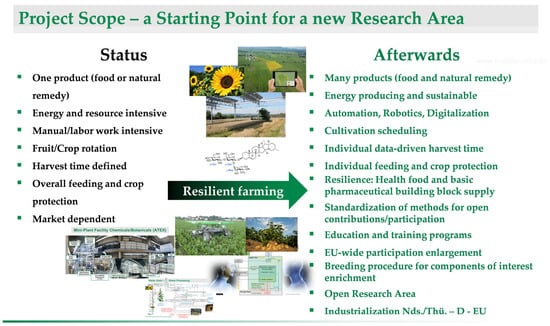
Figure 1.
Summary of the project scope and envisioned goal towards resilient farming.
The consistent application of waste recycling is a crucial innovation in a bio-based world or bio-economy, which encompasses the concept of a circular economy. This approach integrates limited resources, such as agricultural land to feed the world’s population, and the generation of sources of carbon for chemicals and materials, with the objective of minimizing global warming potential and the cost of goods. The adoption of this multi-product-use strategy would enhance the competitiveness of agriculture in the global market. On the agricultural production side, energy supply, further optimization of resource use and an increasing shortage of skilled workers are challenges that need to be solved to further develop existing production systems.
Improvements can be made to energy production and to a possible energy self-sufficiency in agricultural enterprises, for example, with the help of agricultural-photovoltaics (agri-PV). Consistent digitalization can contribute to resource efficiency in the production chain, and robotics can complement employee activities and provide additional resources.
To achieve such benefits, the developed and validated methods need to be broadly applied. To enable such access, lectures, papers, workshops and seminars, as well as training courses, are planned. In addition, newly developed methods will be defined to eventually enable broad participation across Germany and Europe.
1.2. Project Approach: Resilient Farming
The methods and approaches to interdisciplinary tasks are visualized in Figure 2. The goal is resilient farming with (at least in part) a self-sufficient energy supply (e.g., by photovoltaics alone or combined with other renewable energies) and farming with the aid of data-driven approaches, as well as digital technologies (e.g., sensor systems) and robotics as key technologies for a bio-based world/bio-economy. The bio-based approach integrates circular economy waste utilization with multi-product value chains. A core aspect of this project is the utilization of previously unused material flows, with a particular focus on high-value ingredients.

Figure 2.
Representation of the scope of resilient farming [16].
The apple value chain is a classical and well-known example of total waste valorization, where each side stream is totally utilized. However, the achievement of this waste valorization has been a result of decades of production integration which was purely experimental and lacked the use of proposed methods. Nevertheless, this example serves as a good illustration of the potential for waste valorization. This project’s objective is to develop theoretical, a priori methods based on interdisciplinary cooperation between agricultural technology, energy supply, robotics and automation, and processing technology, as shown in Figure 3.
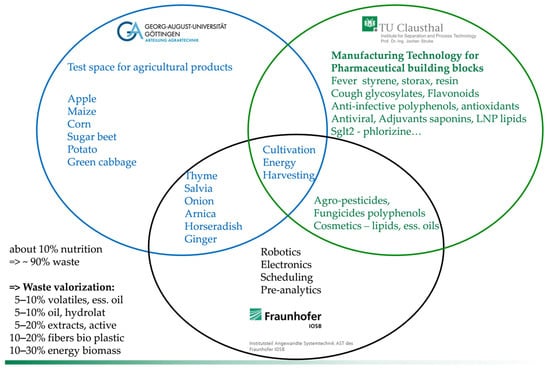
Figure 3.
Presentation of the project partners and expertise in their respective fields of research.
1.3. Project Methods and Partners
The project partners, who provided necessary interdisciplinary knowledge, methods, product expertise and infrastructure, are visualized in Figure 3. Due to their shared interdisciplinary interests, these groups are already interconnected with each other, as well as with other industry specialists, to implement new ideas into their existing infrastructure and procedures. In order to proceed with the implementation of the innovative technologies and techniques, in the kick-off phase the project team will start with examples that allow a holistic view of the value chain, including the use of residual materials. The three project partners are covering the main parts of the whole value chain already, see Figure 3.
Instead of developing completely new concepts, which would involve high investments and a great deal of time, it is possible to start directly with the further development of already-existing methods and analyze their results.
2. Expected Project Results
2.1. Worldwide Nutrition at Economic Benefits Based on Climate Neutrality and Resilience
Agricultural farming suffers from world market competition. The cost of goods as well as GWP have to be minimized to be competitive.
Agricultural space is needed for the nutrition of a growing world population. Any evaluation between tank and plate has been decided towards plate [17,18]. Nevertheless, limited agricultural space is a critically important factor in climate neutrality solutions that bind CO2 and generate O2. The rare resources of space, water and nutrition have to be utilized as efficiently as possible. This is only achieved with multiproduct value chains in a circular economy that avoids losses and waste. Technologies can be used to achieve these goals, such as digitalization, sensor technology, robotics, automation and data driven approaches. The parallel use of agricultural land for agricultural production and energy supply, e.g., as an agri-PV system, could form a further building block of future agricultural systems and help secure the necessary energy supply. The goal is to develop sustainable, consistent land use, which can also be used for multiple purposes (food, resources and energy).
2.2. Potential (Draft Estimation Based on Literature)
The following points have to be considered for the potential of agricultural lands:
- Each hectare is capable of growing approximately 2–80 tons of plant raw material per year, such as 80 tons of beets; medicinal and aromatic plants can contribute approximately 3.5–10 tons towards nutrition [19,20,21,22].
- According to [23], agricultural farming needs only approximately 520 kWh per hectare of electrical power. This would generate approximately 208 kg GWP per hectare, per year with a typical power mix; instead, most of this would be covered by biogas. An additional benefit, for example, is that one-hectare of sugar beets stores approximately 35 t CO2, based on [24], which is twice as effective as forests.
- Previous studies have already pointed out the large 70–80% GWP contribution of the drying process for stable storage and transportation [25]; therefore, fresh plant material has to be processed. This requires a technology change. This is feasible, however there are a lot of processes that would need to be completely changed due to pressing and blocking mechanical differences.
- Sensor technology is able to deliver necessary data for precision farming, e.g., for plant nutrition, water, weeding and harvest time. This helps to optimize care at a plant level instead of the large area application of hydration, pesticide and fertilizer. Thus, saving resources otherwise wasted [26].
- Robotics may help to support the existing workforce in cultivation, plant care and harvesting [27].
These technologies will help to increase the efficiency of agricultural spaces and the workforce employed in this sector. This is shown in Figure 4.
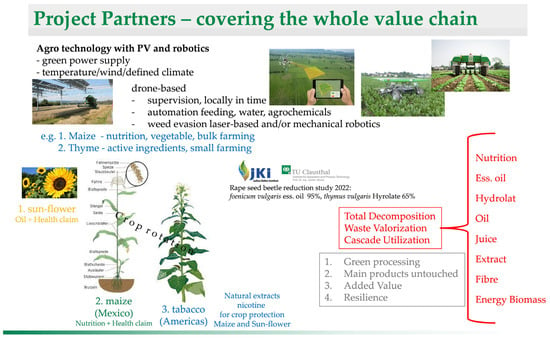
Figure 4.
Robotics-based automation in farming.
The other aspect of agricultural land usage is energy generation through RE. For this, a few points have to be made (estimation based on published studies):
- Lower Saxony needs approximately 55 TWh/a [28] and Germany as a whole needs approximately 562 TWh of electrical energy [29]
- There is approximately 1.9 mil. hectares of agricultural land in Lower Saxony [30] and approximately 12 mil. hectares in total in Germany [31]. This means that while Lower Saxony has low energy usage, it can potentially generate more through agri-PV, making the connection through powerlines to the south a necessity.
- For agri-PV to be integrated into an existing agricultural context, a few key technologies have to be implemented, mainly automation and digitalization. The implementation of digitalization enables efficient organization and decision-making processes, while also effectively managing interconnections [32]. The energy required for such processes can be provided by agri-photovoltaic devices. In a recent study, an energy yield of agri-PV of 300 MWh/ha/a has been calculated [33]. An additional 83% of excess energy (up to 130% if a final biogas plant is applied) is utilized on-site for direct chemical and material product manufacturing [33].
- In contrast to farming, an economic comparison to existing industries and their energy usage can be drawn. The Chemical Pharmaceutical Industry (ChPI) power usage per revenue is a mere 0.5 kWh/EUR 1000 in sales, accounting for less than 1% of the additional power generated [34]. Thus, a hectare yielding approximately EUR 20,000 in additional sales would equal roughly 10 kWh for ChPI manufacturing. This in turn would be less than 1% of the 300 MWh/ha/a PV. Consequently, approximately 80% (−130%) of the agri-PV energy can be allocated towards other social power requirements.
- Agriculture-photovoltaic plants generate approximately 300 MWh per hectare [33], with approximately 30% coverage with agri-PV, i.e., 3000 m2 photovoltaic with approximately 100 kWh/m2. In practice, the share of agri-PV land that can be realized on a large scale still needs to be determined. It should also be noted that not all crops can be grown in agri-PV systems. With 5% of the usable agricultural land, as shown in Figure 5, this would amount to an added electrical energy of 250 TWh annually [35].
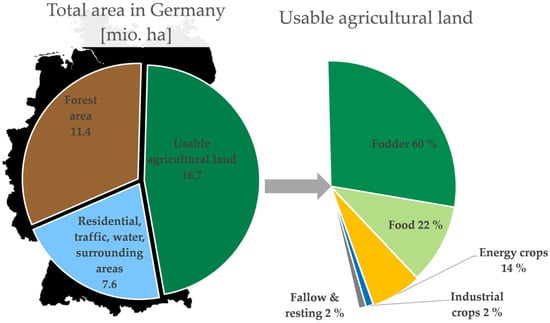 Figure 5. Land usage and usable land for agri-PV in Germany [35].
Figure 5. Land usage and usable land for agri-PV in Germany [35].
In the long-term, increasing automation in watering, care and harvesting of the crop can support these targets [36].
- The Fraunhofer Institute ISE calculates that Germany’s total electricity demand can be met with the use of only 4% of agricultural land. This amounts to a PV capacity of 1700 GW; a utilization of 10% of this potential would mean a tripling of the PV capacity in Germany [33]. According to Weihenstephan, with a yearly production of approximately 35,000 kWh, at an installed capacity of 22 kWp, 1.7 TWp is estimated to be worth approximately 2.7 TWh per year, i.e., only 0.5% of total German needs. However, this is based on only 4% agricultural space utilization. The utilization of all available space would, nevertheless, be a ~12% contribution [33].
- This balance assumes a constant output and consumption, which is not how renewable energy sources and real power usage is observed. Although it has been shown that even without additional energy storage, a small increase in RE of 10 GW offshore wind power output can decrease the natural gas consumption of the German ChPI by 63%, and thus have a great effect on the GWP [37].
2.3. Competitiveness and Resilience
Agriculture is also under general economic pressure. It is not possible to increase profitability by increasing agricultural land overall due to the limited nature of resources. Yields are also at a high level overall and cannot easily be further increased. Another option to further improve the economic situation with the available resources is increasing the value added per hectare. An increase in the value of food products can only be realized to a limited extent, as these must be available to society in sufficient, safe and affordable quantities.
Therefore, additional value per hectare must be generated. Currently, a hectare has a revenue per year of approximately EUR 500–1500 for agriculture and EUR 500–3000 for medicinal and aromatic plants [19,20,22,38,39,40,41,42]. This should be increased by a factor of 5–10 to compete economically with other industries and keep food production local. This is a major challenge that is feasible through waste recovery approaches and the consistent use of agricultural by-products [9,10]. It must be possible for farmers to benefit significantly from the chemicals and materials derived from by-products. The highest added value is achieved in the vicinity of the end product, even up to a factor of 10–100 [43] (see Figure 6).
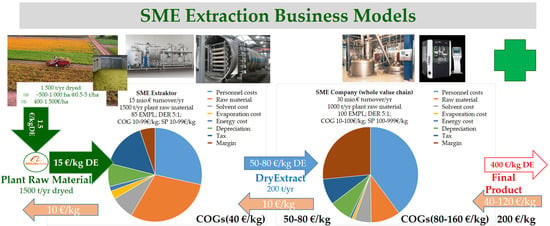
Figure 6.
Business model and value chain from crop to final product with added value in each step [43].
In order to enable farmers to achieve a higher return from these new end products, further production steps need to be performed directly at the farms. Approximately 3–80 to/ha fresh plant material is generated per year ranging from 3–10 to/ha for medicinal and aromatic plants [39,44] and up to 80 to/ta for sugar beets [21]. The potential added value and the reduction in GWP has been analyzed, as further shown in Figure 7:

Figure 7.
Representation of added value per hectare and GWP reduction for multiple products [33,39,41,44,45,46,47,48,49,50,51,52,53,54].
- Main product (No. 1) is still the medicinal and aromatic plant (MaAPlt) or nutrition with approximately EUR 3000–10,000 per hectare yield.
- The waste valorization concept will add a second product (No. 2), such as essential oil via hydrodistillation of fresh plant residues not utilized for the main product. For example, a pesticide derived from polyphenols could give approximately 1 to TS/ha with typically 4–10% content, resulting in approximately 40–100 kg/ha which is approximately EUR 1000–10,000 added value. A relational magnitude could give neem powder a sale price of approximately 13 EUR/100 g or 100 EUR/kg, corresponding with a 10% estimated cost of goods to 10 EUR/kg. A spraying agent like pyrethine amounts to 5–20 g/L of active ingredient at 25 EUR/L i.e., 0.25 EUR/g or 250 EUR/kg sales price. Any aromatic, nutrition, additive flavor, flagrance or food supplement would even generate a sales price that is increased by an approximate factor of 10 [45,46].
- Consequent distinct waste valorization application would generate a third product (No. 3) via solid-liquid-extraction (SLE) and pressurized hot water extraction (PHWE) out of the pomace after hydrodistillation. For example, magnitudes of sglt2 inhibitor have active pharmaceutical ingredient building blocks such as phylorizin inside polyphenol fractions, which work out at 200 EUR/kg API CoGs vs. 2000 EUR/kg sales price; therefore, 10 to/ha with approximately only 0.1% content generate 100 kg/ha with 20,000 EUR/ha manufacturing price [40,47,48,49].
- The sale of agri-PV electrical power would deliver an additional 2.781 EUR/ha/a, coupled with a GWP reduction of 18 t CO2,eq/ha/a [33]
- For the thermal utilization of biomass waste, anaerobic fermentation can still be used to produce biogas or methane. For sugar beet, 22,800 Nm3/ha is estimated for the use of the whole crop and 2800 m3/ha for the waste only [50]. For other aromatic crops, methane production of up to 0.5 Nm3/kg(waste) can be calculated [51]. This can result in methane of up to 5000 m3/ha at a waste to product ratio of 1:1. The efficiency of conversion is given at 46.5% [52]. This can produce 31.1 to 55.5 MWh of energy. Thus 24.3 t CO2,eq can be saved [53] in energy production, which would be worth roughly 2500 EUR/ha with processing costs excluded [54].
Sales price would be increased by a factor of 3–5 for MaAPl to nutrition, 10 for pesticides and >10 for APIs. Due to increasing the product benefit on the market, but not proportionally increasing manufacturing efforts, the profit factors are approximately 5–15% for nutrition and MaAPl, up to 15–20% for fine chemicals and 30–40% for APIs. It is necessary to form organizational alliances to become a fully integrated manufacturer. The technology supplied within this project aims towards flexible and modular plant concepts.
Centuries ago, the sugar industry has demonstrated potential solutions for the organization and integration of end product manufacturing. The organizational solution is cooperation between sugar manufacturers and farmers. Nevertheless, for such a manufacturing solution to be implemented, technology needs to be supplied in a way that is investment, operation and cost optimized. This technology needs to have fast, flexible and modular facilities, and be feasibly operated autonomously, with minimal efforts from personnel [55,56]. Any engineering solution would need to be readily available [57,58,59,60], see Figure 8.
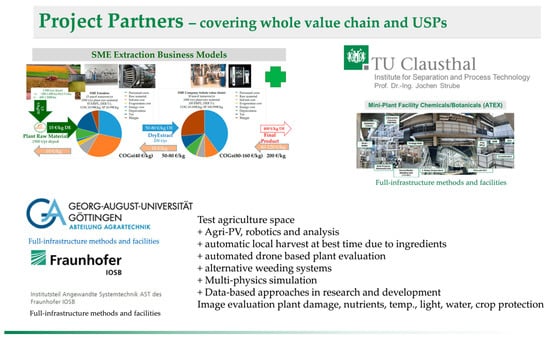
Figure 8.
Display of the project partners, their respective capabilities, expertise and equipment.
GWP reduction is substantially driven by the production of chemical products using climate neutral and energy-generating green manufacturing technologies, which is exemplified in the significant GWP reduction contributed by any additional product. It has been shown in previous works that waste valorization, energy integration and advanced processes such as PHWE can have a significant impact on GWP reduction. For each product, a GWP reduction of 500 t CO2,eq per hectare was assumed, based on the literature [9,10,25].
The significant added value profit shown is partially reduced by the necessary investments in new technology for sustainable resilient agricultural production. However, the magnitude shows that any start-up funding would be ecologically and economically beneficial, and therefore sustainable.
Nevertheless, before any broad industrialization and detail engineering, the process technology for waste valorization value chain multiproduct manufacturing has to be developed, based on green processing principles, as shown in Figure 9.
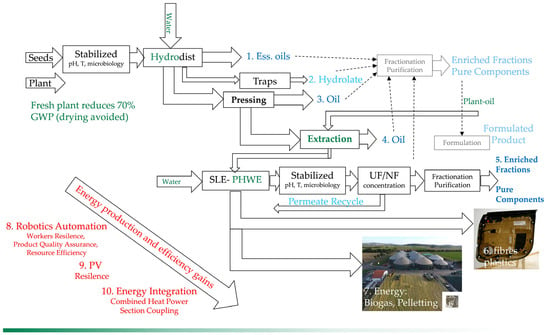
Figure 9.
Representation of the process from acker to product with added values from side products and energy generation along the process route.
3. Discussion
The proposed project follows the value chain from field to product. New technologies are needed in cultivation to maximize yield and minimize the use of inputs. Steps towards digitalization are necessary and lead to more data-driven approaches to strengthen precision farming. This allows for better plant stock management for an increase of quality and quantity per hectare.
3.1. Automation in Farming
Automation in farming is based on continuous information acquisition, dissemination and use. Core technologies include AI, data fusion from remote sensing and local data processed in forecasting models, as well as status detection in plant stock, machinery and the environment. This supports farmers in many areas, such as monitoring soil and plant condition and planning production processes (fertilizing, weeding, harvest, etc.).
Online monitoring of plant conditions with optical or spectral sensors supports the selection of optimal harvest times. A diagnosis of plant health also advances the knowledge of the crop, which can iteratively lead to improved quality and yield [61,62,63]. The technical approaches must enable the idea of waste valorization through the utilization of residual materials and by-products [64].
Sharing this data can also be used in the process development of phyto-extraction. In QbD-based process development, the content of the target component is often a sensitive parameter. Product quality assurance can be achieved by extending monitoring to the field [65].
Automated and semi-automated agricultural processes could be key technologies in the future to make cultivation more resilient. Technological developments affect all scaling levels, from the process level to individual technologies. They can also contribute additional resources if insufficient manpower is available. A large number of projects and studies have already been carried out for this purpose [66,67,68,69,70].
3.2. Process Development
In addition to pesticides and base chemicals, pharmaceuticals can also be obtained through waste valorization. Through QbD-based process development, high-quality pharmaceutical products can be produced from waste streams. This is achieved through the extensive experimental characterization of raw materials and processes. With the help of the project partners, critical quality attributes (CQAs) for the regulatory suitability of products as pharmaceuticals will be established. Through modeling, an in-depth understanding of the processes will be gained, and process parameters will be established within design spaces, where the CQAs can be guaranteed to be met. This is supported by a risk assessment, which serves as the basis for a control strategy. This is supported by process analytical technologies (PAT) and can be demonstrated with simple controls and up to scalable Digital Twins, from the laboratory scale to mini-plant [59,71].
In the view of regulatory issues, some relevant guidelines were published for the development of APIs and pharmaceuticals. Three particular ICH-guidelines are helpful to realize the regulation of this new generation of products. Additionally, REACH, the regulatory body for non-pharmaceuticals and non-food products, prefers the described techniques, for example an extraction of plant material without organic solvent, using only water [72,73,74].
The multi-objective optimization challenges are methodologically approached with the aid of scalable Digital Twins [58,75]. Distinct in accuracy and precision, process models are validated in laboratory scale experiments [59,76], which are adapted to real-time phenomena of plant operation by sensors within PAT approaches [26,60] in order to predict optimal setpoints for process control which enables autonomous operation [58]. Though it is methodologically and interdisciplinarily complex, it has already verified with proof-of-concept studies [71,77,78,79,80,81]. It is also needed to evaluate waste levels and ingredients with regards to processing costs towards final chemicals and material products. Life cycle analysis and GWP vs. CoGs evaluation is included a priori, like any eco-efficiency analysis in the chemical-pharmaceutical industry over the last few decades [82,83]. For the success of this approach, a consideration of the system inter-relationships is imperative. This means a holistic approach from agricultural production to energy supply for the available new product.
3.3. The Road Ahead
The declared goal of the German government and industry is climate neutrality by 2045. Accordingly, the projects that are being tackled now are groundbreaking and have the greatest influence on the outcome of this goal. Nevertheless, for climate neutrality to be widely accepted, prosperity must be maintained. Therefore, for a high reduction of GWP, the highest possible revenue for all stakeholders must be achieved. This can be achieved by establishing new products through waste valorization.
The proposed project is divided into three phases. In the first phase, the effect and potential on GWP and CoGs will be demonstrated using examples. Automation in farming and process development are active areas of research. Figure 10 shows products of particular interest. Data-based approaches are consistently relied upon. In product development and research, new collaborations in industry and research are openly sought, as the subject area and the value chain are far-reaching. This phase is supported by workshops and training of industry personnel.
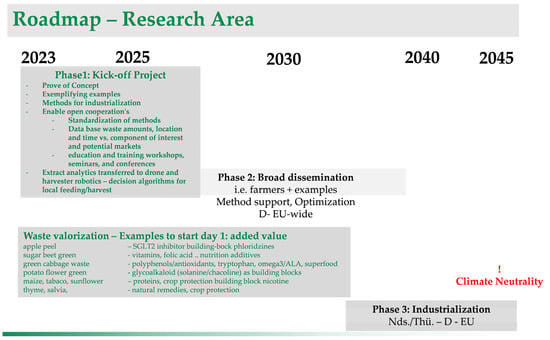
Figure 10.
Roadmap for this project and areas of research for new products and long-term sustainability.
The second phase will be approached in close collaboration with industry and farmers across Europe. The developed technologies and processes will be demonstrated and integrated into active processes. This will serve as a springboard for the third and final phase. In this phase, the achievements from research and development will be applied and operated on an industrial scale. This will lead to a significant reduction in both GWP and CoGs.
4. Conclusions and Outlook
Potential innovative products which reduce the CoGs and GWP towards climate neutrality have been shown. Added value to existing farmland can be as high as 10,000 EUR/ha for a realistic mix of waste valorization and energy generation, as shown in Figure 7. A reduction in GWP of up to 1000 t CO2,eq/ha is possible. This is achieved through the innovation of new products via waste valorization and integrating electrical power generation into farmland. The use of PV and biogas is a key component of energy sustainability and independence from fossil fuels. The main source of added economic value to farmland is the introduction of new products from waste stream through novel green processes and a circular economy. These reduce the need for chemically produced products and thus reduce the GWP and CoGs.
The infrastructure for all necessary disciplines, such as agrotechnology, robotics and automation, as well as chemical-pharmaceutical process technology, is of high quality and is readily available. Collaboration to work towards these goals has begun, but project funds for any broad dissemination are still needed. These concept are embedded within existing regional, national and European mid- and long-term goals for bio-economy and resilient sustainability.
Author Contributions
Conceptualization, A.W., F.B., M.T. and J.S.; writing—original draft preparation, M.T. and J.S.; writing—review and editing, A.U., A.S., A.W. and F.B.; visualization, A.U. and A.S.; supervision, A.W., F.B. and J.S.; project administration, A.W., F.B. and J.S.; funding acquisition, A.W., F.B. and J.S. All authors have read and agreed to the published version of the manuscript.
Funding
This research received no external funding.
Data Availability Statement
Not applicable.
Acknowledgments
The Clausthal authors would like to thank explicitly Michael Gahr, PTJ Jülich for BMWi for his continuous motivation to discuss energy efficiency strategies at various levels. We acknowledge support by Open Access Publishing Fund of Clausthal University of Technology.
Conflicts of Interest
The authors declare no conflict of interest.
References
- IPCC. Climate Change 2022: Impacts, Adaptation and Vulnerability: Contribution of Working Group II to the Sixth Assessment Report of the Intergovernmental Panel on Climate Change; Cambridge University Press: Cambridge, UK; New York, NY, USA, 2021. [Google Scholar] [CrossRef]
- Cook, J.; Oreskes, N.; Doran, P.T.; Anderegg, W.R.L.; Verheggen, B.; Maibach, E.W.; Carlton, J.S.; Lewandowsky, S.; Skuce, A.G.; Green, S.A.; et al. Consensus on consensus: A synthesis of consensus estimates on human-caused global warming. Environ. Res. Lett. 2016, 11, 48002. [Google Scholar] [CrossRef]
- LANXESS to Become Climate Neutral by 2040. Available online: https://lanxess.com/en/Media/Press-Releases/2019/11/LANXESS-to-become-climate-neutral-by-2040 (accessed on 27 March 2023).
- Becks, H.; Gelbke, H. Die Ökoeffizienz-Analyse nach BASF. TATuP 2001, 10, 34–39. [Google Scholar] [CrossRef]
- Ausfelder, F.; Bazzanella, A.M.; Möller, A.; Geres, R.; Wehrl, A.; Lenz, S. Roadmap Chemie 2050: Auf dem Weg zu einer Treibhausgasneutralen Chemischen Industrie in Deutschland; DECHEMA: Frankfurt am Main, Germany, 2019. [Google Scholar]
- Burger, J.; Asprion, N.; Blagov, S.; Böttcher, R.; Nowak, U.; Bortz, M.; Welke, R.; Küfer, K.-H.; Hasse, H. Multi-Objective Optimization and Decision Support in Process Engineering—Implementation and Application. Chem. Ing. Tech. 2014, 86, 1065–1072. [Google Scholar] [CrossRef]
- Linnhoff March. Introduction to Pinch Technology. Available online: https://www.ou.edu/class/che-design/a-design/Introduction%20to%20Pinch%20Technology-LinhoffMarch.pdf (accessed on 27 March 2023).
- Gerbert, P.; Herhold, P.; Burchardt, J.; Schönberger, S.; Rechenmacher, F.; Kirchner, A.; Kemmler, A.; Wünsch, M. Klimapfade für Deutschland; BCG: Boston, MA, USA, 2018. [Google Scholar]
- Jensch, C.; Schmidt, A.; Strube, J. Versatile Green Processing for Recovery of Phenolic Compounds from Natural Product Extracts towards Bioeconomy and Cascade Utilization for Waste Valorization on the Example of Cocoa Bean Shell (CBS). Sustainability 2022, 14, 3126. [Google Scholar] [CrossRef]
- Jensch, C.; Strube, J. Proposal of a New Green Process for Waste Valorization and Cascade Utilization of Essential Oil Plants. Sustainability 2022, 14, 3227. [Google Scholar] [CrossRef]
- Uhlenbrock, L.; Ditz, R.; Strube, J. Process Engineering Accelerating an Economic Industrialization Towards a Bio-Based World. Molecules 2019, 24, 1853. [Google Scholar] [CrossRef]
- Uhl, A.; Schmidt, A.; Jensch, C.; Köster, D.; Strube, J. Development of Concepts for a Climate-Neutral Chemical–Pharmaceutical Industry in 2045. Processes 2022, 10, 1289. [Google Scholar] [CrossRef]
- Moriarty, P.; Honnery, D. The Limits of Renewable Energy. In Switching Off; Moriarty, P., Honnery, D., Eds.; Springer: Singapore, 2022; pp. 35–54. ISBN 978-981-19-0766-1. [Google Scholar]
- Palzer, A.; Henning, H.-M. A comprehensive model for the German electricity and heat sector in a future energy system with a dominant contribution from renewable energy technologies—Part II: Results. Renew. Sustain. Energy Rev. 2014, 30, 1019–1034. [Google Scholar] [CrossRef]
- Pregger, T.; Nitsch, J.; Naegler, T. Long-term scenarios and strategies for the deployment of renewable energies in Germany. Energy Policy 2013, 59, 350–360. [Google Scholar] [CrossRef]
- Vukušić, J.L.; Millenautzki, T.; Cieplik, R.; Obst, V.; Saaid, A.M.; Clavijo, L.; Zlatanovic, S.; Hof, J.; Mösche, M.; Barbe, S. Reshaping Apple Juice Production Into a Zero Discharge Biorefinery Process. Waste Biomass Valorization 2021, 12, 3617–3627. [Google Scholar] [CrossRef]
- Muscat, A.; de Olde, E.M.; de Boer, I.J.M.; Ripoll-Bosch, R. The battle for biomass: A systematic review of food-feed-fuel competition. Glob. Food Secur. 2020, 25, 100330. [Google Scholar] [CrossRef]
- Giller, K.E.; Delaune, T.; Silva, J.V.; Descheemaeker, K.; van de Ven, G.; Schut, A.G.T.; van Wijk, M.; Hammond, J.; Hochman, Z.; Taulya, G.; et al. The future of farming: Who will produce our food? Food Sec. 2021, 13, 1073–1099. [Google Scholar] [CrossRef]
- DBV. Durchschnittliche Hektarerträge bei Weizen und Raps. Available online: https://www.bauernverband.de/presse-medien/pressemitteilungen/pressemitteilung/durchschnittliche-hektarertraege-bei-weizen-und-raps (accessed on 28 February 2023).
- Gabot. Grünkohl: Ernte hat Begonnen. Available online: https://www.gabot.de/ansicht/gruenkohl-ernte-hat-begonnen-394660.html (accessed on 28 February 2023).
- Statista. Zuckerrübenertrag je Hektar in Deutschland 1850–2021. Available online: https://de.statista.com/statistik/daten/studie/165449/umfrage/zuckerruebenertrag-in-deutschland-seit-1850/ (accessed on 28 February 2023).
- Statista. Ertrag je Hektar Anbaufläche von Körnermais in Deutschland bis 2021. Available online: https://de.statista.com/statistik/daten/studie/28894/umfrage/hektarertrag-von-koernermais-in-deutschland-seit-1960/ (accessed on 28 February 2023).
- Neiber, J. Energieeffizienz in der Landwirtschaft: Von der Theorie zur Praxis—Energieverbrauchsmessungen an Landwirtschaftlichen Betrieben; LFL: Dresden, Germany, 2014. [Google Scholar]
- Deter, A. Rübenkampagne: Bauern Informieren über Klimaschutz. 2019. Available online: https://www.topagrar.com/mediathek/fotos/ackerbau/ruebenkampagne-bauern-informieren-ueber-klimaschutz-11817813.html (accessed on 28 February 2023).
- Schmidt, A.; Uhlenbrock, L.; Strube, J. Technical Potential for Energy and GWP Reduction in Chemical–Pharmaceutical Industry in Germany and EU—Focused on Biologics and Botanicals Manufacturing. Processes 2020, 8, 818. [Google Scholar] [CrossRef]
- Jensch, C.; Knierim, L.; Tegtmeier, M.; Strube, J. Development of a General PAT Strategy for Online Monitoring of Complex Mixtures—On the Example of Natural Product Extracts from Bearberry Leaf (Arctostaphylos uva-ursi). Processes 2021, 9, 2129. [Google Scholar] [CrossRef]
- Gindele, N.; Kaps, S.; Doluschitz, R. Betriebliche Möglichkeiten im Umgang mit dem Fachkräftemangel in der Landwirtschaf. Berichte Landwirtsch.-Z. Agrarpolit. Landwirtsch. 2016, 94, 1–14. [Google Scholar] [CrossRef]
- Lies, O. Energiewendebericht 2020-Niedersachsen. 2021. Available online: https://www.google.com/url?sa=t&rct=j&q=&esrc=s&source=web&cd=&ved=2ahUKEwj668Lz44X-AhUQgP0HHUBWD4YQFnoECA4QAQ&url=https%3A%2F%2Fwww.umwelt.niedersachsen.de%2Fdownload%2F168771%2FEnergiewendebericht_2020.pdf&usg=AOvVaw3yvj0fu_UWG2oTKiLSgQlv (accessed on 28 February 2023).
- Umweltbundesamt. Stromverbrauch. Available online: https://www.umweltbundesamt.de/daten/energie/stromverbrauch (accessed on 28 February 2023).
- Agrarland Nummer 1. Nds. Ministerium für Ernährung, Landwirtschaft und Verbraucherschutz. Available online: https://www.ml.niedersachsen.de/startseite/themen/landwirtschaft/landwirtschaft-in-niedersachsen-4513.html (accessed on 28 February 2023).
- Statista. Landwirtschaftliche Nutzfläche in Deutschland nach Nutzungsart 2022. Available online: https://de.statista.com/statistik/daten/studie/183734/umfrage/landwirtschaftliche-nutzflaeche-in-deutschland-2010/ (accessed on 28 February 2023).
- BMEL. Digitalisierung in der Landwirtschaft. Available online: https://www.bmel.de/DE/themen/digitalisierung/digitalisierung-landwirtschaft.html (accessed on 28 February 2023).
- Trommsdorff, M.; Gruber, S.; Keinath, T.; Hopf, M.; Hermann, C.; Schönberger, F.; Högy, P.; Zikeli, S.; Ehmann, A.; Weslek, A.; et al. Agri-Photovoltaik: Chance für Landwirtschaft und Energiewende: Ein Leitfaden für Deutschland; Fraunhofer ISE: Freiburg, Germany, 2022. [Google Scholar]
- VCI. Energiestatistik im Überblick. Available online: https://www.vci.de/die-branche/zahlen-berichte/vci-statistik-grafiken-energie-klima-rohstoffe-chemie.jsp (accessed on 28 February 2023).
- Becker, A.; Peters, D.; Kemnitz, D. Anbau und Verwendung Nachwachsender Rohstoffe in Deutschland; FNR: Gülzow, Germany, 2019. [Google Scholar]
- Doormann, G. Leistung von Photovoltaikanlagen. 2022. Available online: https://www.solaranlagen-portal.com/photovoltaik/leistung (accessed on 1 March 2023).
- Riedel, N.H.; Špaček, M. Challenges of Renewable Energy Sourcing in the Process Industries: The Example of the German Chemical Industry. Sustainability 2022, 14, 13520. [Google Scholar] [CrossRef]
- IBISWorld. Industry Market Research, Reports, and Statistics. Available online: https://www.ibisworld.com/de/bed/erzeugerpreis-fuer-pharmazeutische-aehnliche-erzeugnisse/465/ (accessed on 10 March 2023).
- Paul, N. Kamille, Melisse und Baldrian Erfolgreicher Anbauen; FNR: Gülzow, Germany, 2017. [Google Scholar]
- 2000 m2. Anbau-Beispiel: Was Lässt Sich auf 2000 m2 Alles Anbauen? Available online: https://www.2000m2.eu/de/ernte/ (accessed on 28 February 2023).
- Agrarheute.com. Erzeugerpreise für Mais vom 10.03.2023. Available online: https://markt.agrarheute.com/marktfruechte-1/mais-8 (accessed on 10 March 2023).
- Zinke, O. Wo Verdienen die Bauern am Meisten Geld—Und Womit? Available online: https://www.agrarheute.com/management/betriebsfuehrung/verdienen-bauern-meisten-geld-womit-regionen-580891 (accessed on 13 March 2023).
- Uhlenbrock, L.; Sixt, M.; Tegtmeier, M.; Schulz, H.; Hagels, H.; Ditz, R.; Strube, J. Natural Products Extraction of the Future—Sustainable Manufacturing Solutions for Societal Needs. Processes 2018, 6, 177. [Google Scholar] [CrossRef]
- Kommunikation und Öffentlichkeitsarbeit. Echte Kamille: Publikationen. Available online: https://publikationen.sachsen.de/bdb/artikel/13526 (accessed on 28 February 2023).
- Kerkel, F.; Markiewicz, M.; Stolte, S.; Müller, E.; Kunz, W. The green platform molecule gamma-valerolactone—Ecotoxicity, biodegradability, solvent properties, and potential applications. Green Chem. 2021, 23, 2962–2976. [Google Scholar] [CrossRef]
- Flemming, M. Iris im Zentrum der Kreation eines Eigenen Parfums. SKH GmbH. Available online: https://www.skh-gmbh.de/news/parfum-iris (accessed on 2 March 2023).
- Bezarević, I. Ernteerträge in Gewächshäusern bis zu 10 mal höher-Mindestens 5 ha für Rentable Produktion, Mangelhafte Finanzierungsquellen Verhindern größere Investitionen. Available online: https://www.ekapija.com/de/where-to-invest/1521394/ernteertraege-in-gewaechshaeusern-bis-zu-10-mal-hoeher-mindestens-5-ha-fuer (accessed on 28 February 2023).
- KrosAgro. Gewächshausgewinn pro Quadratfuß: 5 neue Pflanzen Wachsen!: Folientunnel-Leitfaden. Available online: https://krosagro.com/de/folientunnel/gewaechshausgewinn-pro-quadratfuss-5-neue-pflanzen-wachsen/ (accessed on 28 February 2023).
- Rascher, B.; Schubert, W. Das Schnellere Ernten Gleicht den Hohen Zeitaufwand für das Layern der Tomaten am Hohen Draht aus; Bayrische Landesanstalt für Weinbau und Gartenbau: Bamberg, Germany, 2014. [Google Scholar]
- Starke, P. (Ed.) Nutzung von Zuckerrüben für die Biogaserzeugung—Definition der Qualität sowie Ertragsrelevante Parameter von Rübe, Blatt und Schossern; Cuvillier Verlag Göttingen: Göttingen, Germany, 2014. [Google Scholar]
- Wellinger, A.; Murphy, J.D.; Baxter, D. (Eds.) The Biogas Handbook: Science, Production and Applications; Woodhead Publishing Ltd.: Oxford, UK, 2013; ISBN 978-0-85709-498-8. [Google Scholar]
- Abanades, S.; Abbaspour, H.; Ahmadi, A.; Das, B.; Ehyaei, M.A.; Esmaeilion, F.; El Haj Assad, M.; Hajilounezhad, T.; Hmida, A.; Rosen, M.A.; et al. A conceptual review of sustainable electrical power generation from biogas. Energy Sci. Eng. 2022, 10, 630–655. [Google Scholar] [CrossRef]
- Umweltbundesamt. CO₂-Emissionen pro Kilowattstunde Strom Steigen 2021 Wieder an. Available online: https://www.umweltbundesamt.de/themen/co2-emissionen-pro-kilowattstunde-strom-steigen (accessed on 1 March 2023).
- FNR—Biogas: Faustzahlen. Available online: https://biogas.fnr.de/daten-und-fakten/faustzahlen (accessed on 1 March 2023).
- Sixt, M.; Schmidt, A.; Mestmäcker, F.; Huter, M.; Uhlenbrock, L.; Strube, J. Systematic and Model-Assisted Process Design for the Extraction and Purification of Artemisinin from Artemisia annua L.—Part I: Conceptual Process Design and Cost Estimation. Processes 2018, 6, 161. [Google Scholar] [CrossRef]
- Vetter, F.L.; Strube, J. Enabling Total Process Digital Twin in Sugar Refining through the Integration of Secondary Crystallization Influences. Processes 2022, 10, 373. [Google Scholar] [CrossRef]
- Vetter, F.L.; Zobel-Roos, S.; Strube, J. PAT for Continuous Chromatography Integrated into Continuous Manufacturing of Biologics towards Autonomous Operation. Processes 2021, 9, 472. [Google Scholar] [CrossRef]
- Schmidt, A.; Zobel-Roos, S.; Helgers, H.; Lohmann, L.; Vetter, F.; Jensch, C.; Juckers, A.; Strube, J. Digital Twins for Continuous Biologics Manufacturing. In Process Control, Intensification, and Digitalisation in Continuous Biomanufacturing; Subramanian, G., Ed.; Wiley-VCH: Weinheim, Germany, 2022; pp. 265–350. ISBN 9783527347698. [Google Scholar]
- Sixt, M.; Uhlenbrock, L.; Strube, J. Toward a Distinct and Quantitative Validation Method for Predictive Process Modelling—On the Example of Solid-Liquid Extraction Processes of Complex Plant Extracts. Processes 2018, 6, 66. [Google Scholar] [CrossRef]
- Sixt, M.; Gudi, G.; Schulz, H.; Strube, J. In-line Raman spectroscopy and advanced process control for the extraction of anethole and fenchone from fennel (Foeniculum vulgare L. MILL.). Comptes Rendus Chim. 2018, 21, 97–103. [Google Scholar] [CrossRef]
- Kaidi, H.M.; Ahmad, N.; Dziyauddin, R.A.; Mohamed, N.; Latiff, L.A.; Usman, S.; Ahmad, R.; Sarip, S. Internet of Things: A Monitoring and Control System for Rockmelon Farming. IJIE 2020, 12, 55–61. [Google Scholar]
- Terence, S.; Purushothaman, G. Systematic review of Internet of Things in smart farming. Trans. Emerg. Tel. Tech. 2020, 31, e3958. [Google Scholar] [CrossRef]
- Meyer-Aurich, A.; Gandorfer, M.; Barta, N.; Gronauer, A.; Kantelhardt, J.; Floto, H. (Eds.) Fokus: Digitalisierung für Landwirtschaftliche Betriebe in Kleinstrukturierten Regionen: Ein Widerspruch in Sich? Informatik in der Land-, Forst- und Ernährungswirtschaft: Referate der 39. GIL-Jahrestagung, 18–19 February 2019, Wien, Österreich; Gesellschaft für Informatik e.V.: Bonn, Germany, 2019; ISBN 9783885796817. [Google Scholar]
- Beneke, F.; Rumpler, J. Application of sensitivity models for renewable resources and co-products. In Proceedings of the First International Conference on Resource Efficiency in Interorganizational Networks-ResEff 2013, Universitätsverlag Göttingen, Göttingen, Germany, 13–14 November 2013; Georg-August-Universität Göttingen, Papers; Geldermann, J., Schumann, M., Eds.; Universitätsverlag Göttingen: Göttingen, Germany, 2013; pp. 57–68. ISBN 9783863951429. [Google Scholar]
- Uhlenbrock, L.; Jensch, C.; Tegtmeier, M.; Strube, J. Digital Twin for Extraction Process Design and Operation. Processes 2020, 8, 866. [Google Scholar] [CrossRef]
- Siebald, H.; Hensel, O.; Beneke, F.; Merbach, L.; Walther, C.; Kirchner, S.M.; Huster, J. Real-Time Acoustic Monitoring of Cutting Blade Sharpness in Agricultural Machinery. IEEE/ASME Trans. Mechatron 2017, 22, 2411–2419. [Google Scholar] [CrossRef]
- Siebald, H.; Pforte, F.; Kulig, B.; Schneider, M.; Wenzel, A.; Schweigel, M.; Lorenz, J.; Kaufmann, H.-H.; Huster, J.; Beneke, F.; et al. Referencing acoustic monitoring of cutting knives sharpness in agricultural harvesting processes using image analysis. Biosyst. Eng. 2023, 226, 86–98. [Google Scholar] [CrossRef]
- Walther, C.; Wenzel, A.; Beneke, F.; Hensel, O.; Huster, J. Determination of working states of the rotating cutting assembly in forage harvesters by artificial neural networks. Automatisierungstechnik 2017, 65, 198–206. [Google Scholar] [CrossRef]
- Schneider, M.; Schweigel, M.; Walther, C.; Merbach, L.; Hartwig, S.; Wenzel, A.; Beneke, F.; Huster, J. Erfassung des realen Messerzustandes von selbstfahrenden Feldhäckslern unter Verwendung automatisierter Bild-auswertung: 23. Workshop Computer-Bildanalyse in der Landwirtschaft. Bornimer Agrartech. Berichte 2017, 93, 247–261. [Google Scholar]
- Beerbaum, S.; Beneke, F.; Buitkamp, H.; Franchi, N.; Franko, J.; Frerichs, A.; Griepentrog, H.W.; Herlitzius, T.; Heß, P.; Kaufmann, H.; et al. Positionspapier der Arbeitsgruppe “Adaptive autonome Agrarsysteme“. Kompetenznetzwerk Digitalisierung in der Landwirtschaft; Bundesministerium für Ernährung und Landwirtschaft: Berlin, Germany, 2022. [Google Scholar]
- Schmidt, A.; Helgers, H.; Lohmann, L.J.; Vetter, F.; Juckers, A.; Mouellef, M.; Zobel-Roos, S.; Strube, J. Process analytical technology as key-enabler for digital twins in continuous biomanufacturing. J. Chem. Tech. Biotech. 2022, 97, 2336–2346. [Google Scholar] [CrossRef]
- European Medicines Agency. ICH Guideline Q13 on Continuous Manufacturing of Drug Substances and Drug Products EMA/CHMP/ICH/427817/2021; European Medicines Agency: Amsterdam, The Netherlands, 2023. [Google Scholar]
- European Medicines Agency. ICH Guideline Q8 (R2) on Pharmaceutical Development; EMA/CHMP/ICH/167068/2004; European Medicines Agency: Amsterdam, The Netherlands, 2006. [Google Scholar]
- European Medicines Agency. ICH Guideline Q11 on Development and Manufacture of Drug Substances (Chemical Entities and Biotechnological/Biological Entities) EMA/CHMP/ICH/425213/2011; European Medicines Agency: Amsterdam, The Netherlands, 2012. [Google Scholar]
- Zobel-Roos, S.; Schmidt, A.; Mestmäcker, F.; Mouellef, M.; Huter, M.; Uhlenbrock, L.; Kornecki, M.; Lohmann, L.; Ditz, R.; Strube, J. Accelerating Biologics Manufacturing by Modeling or: Is Approval under the QbD and PAT Approaches Demanded by Authorities Acceptable Without a Digital-Twin? Processes 2019, 7, 94. [Google Scholar] [CrossRef]
- Roth, T.; Uhlenbrock, L.; Strube, J. Distinct and Quantitative Validation for Predictive Process Modelling in Steam Distillation of Caraway Fruits and Lavender Flower Following a Quality-By-Design (QbD) Approach. Processes 2020, 8, 594. [Google Scholar] [CrossRef]
- Uhl, A.; Schmidt, A.; Hlawitschka, M.W.; Strube, J. Autonomous Liquid–Liquid Extraction Operation in Biologics Manufacturing with Aid of a Digital Twin including Process Analytical Technology. Processes 2023, 11, 553. [Google Scholar] [CrossRef]
- Schmidt, A.; Helgers, H.; Vetter, F.L.; Juckers, A.; Strube, J. Fast and Flexible mRNA Vaccine Manufacturing as a Solution to Pandemic Situations by Adopting Chemical Engineering Good Practice—Continuous Autonomous Operation in Stainless Steel Equipment Concepts. Processes 2021, 9, 1874. [Google Scholar] [CrossRef]
- Schmidt, A.; Helgers, H.; Vetter, F.L.; Zobel-Roos, S.; Hengelbrock, A.; Strube, J. Process Automation and Control Strategy by Quality-by-Design in Total Continuous mRNA Manufacturing Platforms. Processes 2022, 10, 1783. [Google Scholar] [CrossRef]
- Vetter, F.L.; Zobel-Roos, S.; Mota, J.P.B.; Nilsson, B.; Schmidt, A.; Strube, J. Toward Autonomous Production of mRNA-Therapeutics in the Light of Advanced Process Control and Traditional Control Strategies for Chromatography. Processes 2022, 10, 1868. [Google Scholar] [CrossRef]
- Zobel-Roos, S.; Schmidt, A.; Uhlenbrock, L.; Ditz, R.; Köster, D.; Strube, J. Digital Twins in Biomanufacturing. Adv. Biochem. Eng. Biotechnol. 2021, 176, 181–262. [Google Scholar] [CrossRef]
- BASF Corporate Sustainability. BASF Methodology for Product Carbon Footprint Calculation; BASF: Seoul, Republic of Korea, 2022. [Google Scholar]
- Maga, D.; Aryan, V.; Blömer, J. Vergleichende Ökobilanz von End-of-Life-Optionen für Altreifen; Fraunhofer ISE: Freiburg, Germany, 2022. [Google Scholar]
Disclaimer/Publisher’s Note: The statements, opinions and data contained in all publications are solely those of the individual author(s) and contributor(s) and not of MDPI and/or the editor(s). MDPI and/or the editor(s) disclaim responsibility for any injury to people or property resulting from any ideas, methods, instructions or products referred to in the content. |
© 2023 by the authors. Licensee MDPI, Basel, Switzerland. This article is an open access article distributed under the terms and conditions of the Creative Commons Attribution (CC BY) license (https://creativecommons.org/licenses/by/4.0/).